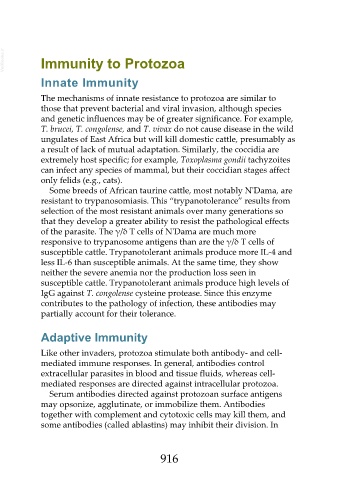Page 916 - Veterinary Immunology, 10th Edition
P. 916
VetBooks.ir Immunity to Protozoa
Innate Immunity
The mechanisms of innate resistance to protozoa are similar to
those that prevent bacterial and viral invasion, although species
and genetic influences may be of greater significance. For example,
T. brucei, T. congolense, and T. vivax do not cause disease in the wild
ungulates of East Africa but will kill domestic cattle, presumably as
a result of lack of mutual adaptation. Similarly, the coccidia are
extremely host specific; for example, Toxoplasma gondii tachyzoites
can infect any species of mammal, but their coccidian stages affect
only felids (e.g., cats).
Some breeds of African taurine cattle, most notably N'Dama, are
resistant to trypanosomiasis. This “trypanotolerance” results from
selection of the most resistant animals over many generations so
that they develop a greater ability to resist the pathological effects
of the parasite. The γ/δ T cells of N'Dama are much more
responsive to trypanosome antigens than are the γ/δ T cells of
susceptible cattle. Trypanotolerant animals produce more IL-4 and
less IL-6 than susceptible animals. At the same time, they show
neither the severe anemia nor the production loss seen in
susceptible cattle. Trypanotolerant animals produce high levels of
IgG against T. congolense cysteine protease. Since this enzyme
contributes to the pathology of infection, these antibodies may
partially account for their tolerance.
Adaptive Immunity
Like other invaders, protozoa stimulate both antibody- and cell-
mediated immune responses. In general, antibodies control
extracellular parasites in blood and tissue fluids, whereas cell-
mediated responses are directed against intracellular protozoa.
Serum antibodies directed against protozoan surface antigens
may opsonize, agglutinate, or immobilize them. Antibodies
together with complement and cytotoxic cells may kill them, and
some antibodies (called ablastins) may inhibit their division. In
916

